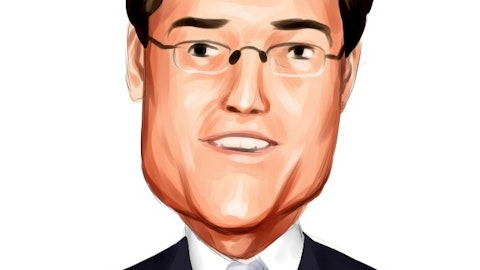Douglas Bettinger: Yes, Srini. I guess what I described is you think about the advanced payment is when we have a new customer that we’re just kind of understanding what their balance sheet looks like, especially if they’re a private customer that we could see the balance sheet. It’s not publicly reported. And the creditworthiness might be sort of questionable. We require cash upfront before we begin manufacturing the tool, and that’s what’s going on there. That’s all it is.
Operator: The next question is from Stacy Rasgon with Bernstein Research.
Stacy Rasgon: For the first one, around the China BOP being stable in calendar ’24. Do you see all market segments being stable? Or do you see some like being stronger and some being weaker? Like how do you see that interplay?
Douglas Bettinger: Stacy, I don’t really see a big change year-on-year relative to end market. I’ll remind you, when China DRAM was second half weighted last year. It’s probably a little bit first half weighted in China, maybe more than a little bit this year. But year-over-year, I don’t think I really think about a significant change in contribution for the entire year.
Stacy Rasgon: Got it. That’s helpful. And I guess a follow-up on the China questions, and maybe it’s a follow-up on one of the earlier questions. But it does sound to me like you are suggesting China mix should come down through the year. Maybe you can clarify that because if I’ve got overall stable China revenues like how does your China mix come down materially? It doesn’t look like you’re looking for overall like non-China WFE to grow a ton, right, in some of the other areas. So…
Douglas Bettinger: Yes. Let me remind you, in 2023, China was a more modest amount of WFE that grew in the second half of the year. And so the comments we’re making are year-over-year, it’s relatively stable. Kind of the half-on-half stuff probably looks different in ’24 than it did in ’23 in China specifically.
Stacy Rasgon: That’s helpful. And so then exiting the year, you think you’re back to that sort of normalized gross margin range as a result of that as China falls off in the second half?
Douglas Bettinger: Yes. The customer mix stuff, I think, mitigates some as we go through the year, and it continues to be quite strong in the March quarter guidance.
Operator: The next question is from Vivek Arya from Bank of America Securities.
Vivek Arya: For my first one, I’m curious, what’s your assessment of NAND supply demand as it exists today? I think in your WFE view, you are assuming that NAND grows but more because of technology upgrades. But what are your customers telling you for as to when they want to start adding more tools? And what’s Lam’s opportunity to grow NAND right at a measurable pace in the second half of the year?
Timothy Archer: Yes. I think that — first of all, I wouldn’t necessarily talk about what we are discussing with our customers on that standpoint. But things that are out there. We do know, and I think you know that the utilization cuts were pretty severe in NAND last year. And so there’s a tremendous amount of capacity that is — has been offline and we’ve said in the past that needs to be brought back online. And I think the question and the discussions we’re having is that what technology node should that capacity be restarted. And in many cases, there is a very high likelihood that technology upgrade certainly will occur as that equipment is brought back into service. And so in that case, we would actually begin to see a restart of some of the utilization driven revenue that we get from things like spares and services, as well as, at the same time, a restart of technology upgrade revenues.
And that’s why I think that from a NAND perspective this year, we think that will effectively represent the majority of the spend that occurs in this segment.
Vivek Arya: Okay. And then, Tim, as many of the DRAM customers are saying that they plan to shift a bit more towards HVM from DDR. Does that have any positive or negative influence on your CSBG and the spares business?
Timothy Archer: No, I don’t — I can’t quite make that connection right now. I’m off to give us some thought. But clearly, we see an impact on our systems business, as I mentioned, where we’re having to add the specific HVM related especially advanced packaging steps related to the stacking of HVM itself. And we’re seeing significant growth in that area. But — and so with that, given we’re shipping additional systems, there is some incremental spares business and services business that goes along with that. But the systems portion of that kind outweighs from a dollars perspective.





